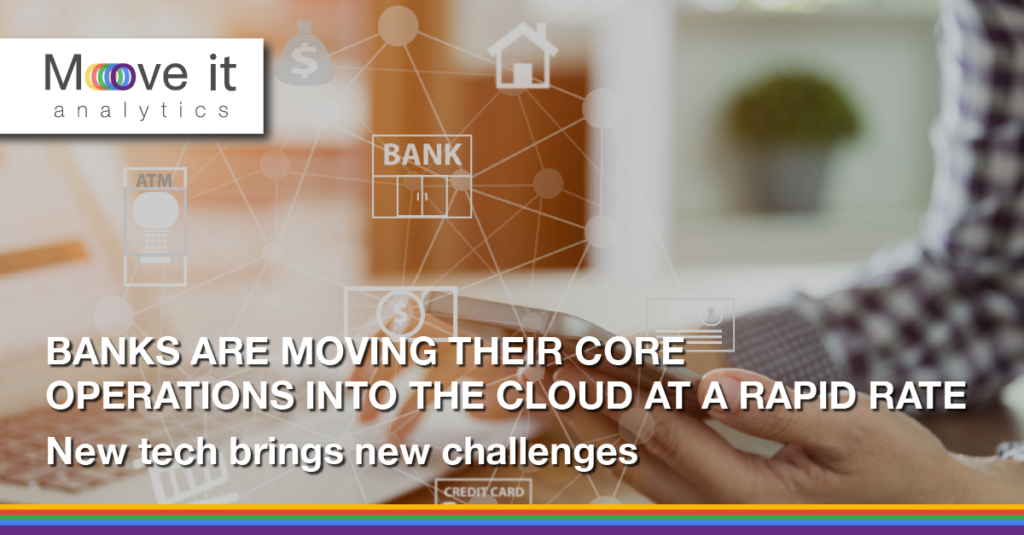
Research commissioned by Google finds that cloud technologies could lead the digital revolution in finance. But cloud strategies need to include strong risk management.
Banks are increasingly turning to the cloud in an effort to modernize their outdated IT models and better compete for customers’ favors, finds a new report commissioned by Google – even though relying on cloud providers for critical services like finance comes with its fair share of risk.
The research, which surveyed more than 1,300 leaders from the financial services industry across the globe, found that an overwhelming 83% of respondents said that their companies were deploying cloud technology as part of their primary computing infrastructures.
In contrast, only 17% of organizations still rely primarily on on-premises services – and among those, respondents said that they planned to switch on average 40% of their workloads to the public cloud during the next year.
Cloud computing is seen as a key technology to future-proof the banking industry. Large-scale cloud providers such as Microsoft Azure and AWS have the capabilities to implement infrastructure that is specifically built to better protect workloads from failure, meaning better operational resiliency. The cloud is also seen as a way to support the creation of new products and services, improve data security, and better connect legacy software infrastructure.
A recent analysis by the Bank of England, in fact, estimated that adopting the ready-made services offered by hyperscalers could reduce technology infrastructure costs by up to 50%.
The top reason cited by decision makers for favoring a switch to the cloud, however, is that the technology helps companies adapt to changing customer expectations. This can be linked to the rise of disruptive fintech start-ups that were born in the cloud and are now competing against traditional financial institutions with innovative and flexible offerings for customers.
According to PwC, almost three-quarters of financial sector executives perceive consumer banking as most likely to be disrupted by fintech.
“There are almost two tiers of banks. You have traditional banks sitting on legacy technology and then the likes of Revolut and all these other banks that are starting up, that are born in the cloud and born to be digital,” Leighton James, the CTO of UKCloud, which provides multi-cloud services to public sector organizations in the UK, told ZDNet.
James argued that there is an imperative for traditional financial institutions, that are facing mounting competition from younger players, to transform digitally.
Google’s latest report confirms the trend. The research found that although the vast majority of financial institutions have adopted cloud technologies in some form or other, organizations are still keeping some of their core activities on-premises. These activities, said Google, “can and will” be migrated to the cloud.
“Financial services firms should continue to maximize the potential of technology by migrating more core workloads to the cloud,” said Zac Maufe, managing director at Google Cloud Financial Services, in a blog post.
In a recent press conference, top executives from the Bank of England seemed to align with this prediction. While, until recently, cloud services were used mostly to run applications at the periphery of banking operations such as HR systems, said the Bank of England, financial institutions are now increasingly migrating processes that are more integral to the core running of banks.
This inevitably comes with some risks. The cloud market is currently shared between less than a handful of huge tech players, with the top five providers accounting for 80% of shares. Amazon’s AWS on its own holds 41% of the market, while Microsoft Azure represents nearly 20% of shares.
From a security perspective, outsourcing critical financial services to such a small set of third parties is a double-edged sword. While hyperscalers have better means to integrate resiliency in their infrastructure, for example thanks to multiple levels of redundancy, there is always a risk of failure – and if every bank relies on the same providers, it could endanger the entire system.
Imagine a situation where the biggest banks in the UK are all using one cloud and there was a problem, said James: “That’s a big part of our critical national infrastructure going down.”
What’s more: as with any concentrated market, there is a risk that cloud providers might start dictating their own terms, at the expense of the stability of the financial system. For example, they could refuse to be transparent by failing to open up their technologies to third-party scrutiny, meaning that it would be impossible to know if providers have baked in sufficient resiliency to carry out banking operations.
Modernizing is key, therefore, but it needs to be done cautiously, and with a reliable strategy. For James, the best way forward is to deploy multi-cloud configurations in the financial sector to balance the risk across multiple providers.
Only 17% of the financial institutions surveyed by Google have already adopted multi-cloud as an architecture of choice, while 28% rely on single cloud. According to the company, more work needs to be done from a regulatory aspect to incentivize a robust and responsible adoption of cloud among financial organizations.
“Consumers’ demand for very quick transformation is becoming really overwhelming, and financial services organizations will take shortcuts to deliver on customer expectations as soon as possible,” said James. “But they need to make sure it’s done right the first time.”
The European Union, for example, is setting up new initiatives to improve the resiliency of cloud technologies. The bloc is currently implementing the GAIA-X project, a cloud marketplace that cloud providers can join if they abide by certain values, including data sovereignty, data availability, interoperability, transparency and fair participation – with the end goal of mitigating reliance on US- and China-based hyperscalers.
Taken directly from: https://www.zdnet.com/article/banks-are-moving-their-core-operations-into-the-cloud-at-a-rapid-rate-but-new-tech-brings-new-challenges/
Article by: Daphne Leprince-Ringuet
In association with Google Cloud and Looker, Move It Analytics is offering a FREE Data Health Check. In this 60-min consultation, you’ll learn how the cloud can help your business grow and take it to the next level.
